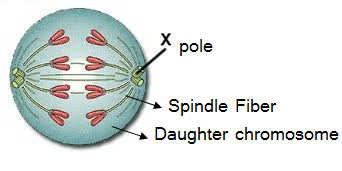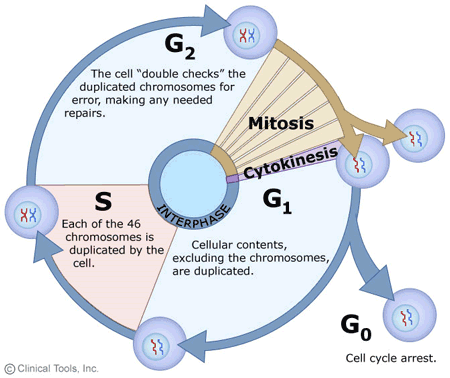Q 1. Define cell cycle
Ans. The sequence of events by which cell duplicates its genome, synthesis of other constituents of the cell and eventually divides into two daughters cell.
Q2. Name the phases of cell cycle
Ans. A) Interphase B) M Phase
Q3. What is the G1phase of the interphase?
Ans. The G1 phase Corresponds to interval between mitosis & initiation of DNA replication.
Q4. Which phase follows the S phase in the cell cycle?
Ans. G2 Phase
Q5. What is mitosis?
Ans. Cell divides equally to produce identical daughter cell so that they receive an equal number of chromosomes as that of its parents cell.
Q6. What is meiosis?
Ans. It is a special type of division takes place in the gonads during gametogenesis by which the diploid cell undergoes division producing haploid daughter cells.
Q7. In which phase of cell division crossing over?
Ans. During pachytene of prophase-1
Q8. What term is used for a full set of DNA instructions in a cell?
Ans. Genome
Q9. In which phase of the cell division the chromosomes are set free in the cytoplasm?
Ans. Metaphase
Q10. By which method cytokinesis occurs in animals cells?
Ans. By process of furrowing of plasma membrane exactly at the middle.
Q11. What is the significance of Pachytene?
Ans. Genetic recombination occurs.
Q12. At What stage of mitosis, chromosomes arrange themselves around the equator?
Ans. Metaphase
Q13. What is karyokinesis?
Ans. It is a process of division of nucleus into daughter nuclei in a dividing cell. or segregation of duplicated chromosome into daughter nuclei.
Q14. What is cytokinesis?
Ans. Division of cytoplasm
Q15. What is the average cell cycle span for mammalian cell?
Ans. 24 hours
Q16. What is the quiescent phase (G0)?
Ans. Go Phase means cell remain metabolically active but no longer proliferate.
Q17. Why mitosis is called equational division?
Ans. Since no of chromosomes in the parent and progeny cells is the same time.
Q18. What are bivalents?
Ans. The homologous chromosomes which are involved in the pairing process are called bivalent
Q19. What is the Synapse?
Ans. The process of the pairing of homologous chromosomes during zygotene
Q20. What is chaismata?
Ans. cytological appearance of X mark at the site of recombination
Q21. Why meiosis is called reductional division?
Ans. When cell undergoes meiotic division that daughter cells receive half the chromosome number that of it’s parent cell.
Q22. What is termilization?
Ans. It is the process of movement of X mark appearance from the middle of the chromatids to the end of the chromatids of homologous chromosomes.
Q23. What is the cell plate?
Ans. It is a precursor of cell wall formed at middle of the nuclei in a divisional cell. later forms middle lamella
Q24. In yeast, mitosis is a means of reproduction, Why?
Ans. The yeast is a unicellular organism
Q25. Mention the significance of chaismata.
Ans. Chaismata helps in exchange of part of the chromatids of non-sister chromatids.
Q26. In which phase of the M phases the morphology of the chromosome can be best studied?
Ans. Metaphase
Q27. What is a metaphasic plate?
Ans. The plane of alignment of the chromosomes at the equator
Q28. Name the pathological condition when uncontrolled cell division occurs.
Ans. Cancer
Q29. Name the enzyme which is involved in crossing over.
Ans. Recombinase
Q30. What is the significance of crossing over?
Ans. Crossing over helps in genetic recombination
Q31. What is mean by recombination?
Ans. It is a process of exchange of part of the chromatids of non-sister chromatids of homologous chromosomes
Q32. What is interphase
Ans. The phase between two successive M phases
Q33. Which phases of the cell cycle take longer time to complete
Ans. Interphase
Q34. Name the adult animal cell which does not divide
Ans. Heart cells
Q35. What is syncytium?
Ans. It is a multinucleate condition arise due to karyokinesis not followed by cytokinesis
Q36. Give an example for syncytium
Ans. Liquid endosperm in coconut
Q37. What id diad?
Ans. The two haploid daughter cell still attached to each other at the end of telophase-1 is called diad.
Q38. What is interkinesis?
Ans. The stage between the two meiotic divisions
Q39. What is tetrad?
Ans. The four haploid cell still attached together at the end of telophase-II
Q40. Mention the role of centriole during cell division?
Ans.
A) Centriole undergoes duplication during S-phase
B) it establishes the polarity in a divisional cell
C) it produces spindle fibres
Q41. Write the difference between zygotene and pachytene?
Ans.
Zygotene | Pachytene |
The homologous chromosome started pairing | The bivalents clearly appear as tetrads |
Formation of synaptonemal complex | Appearance of recombination nodules |
Q42. 3. Draw a labelled diagram of Anaphase.
Ans.

Q43. Write any two significance of mitosis?
Ans. a) The mitosis helps in increase in the number of cells
b) In unicellular organism it is a means of reproduction
Q44. Two events occur during S – phase in animal DNA replication and duplication of the centriole. In which parts of the cell do events occur?
Ans. DNA replication —Occur in nucleus
Duplication of centriole —Occur in cytoplasm
Q45. Comment on the statement “Meiosis enables the conservation of specific chromosome number of each species even though the process actually results in reduction of chromosome number.
Ans. During gamete formation parent diploid cell undergoes meiosis producing two haploid cells, they become gametes. The two male and female haploid gametes fuse together to form a zygote – restoring diploidy





Leave a Reply
You must be logged in to post a comment.